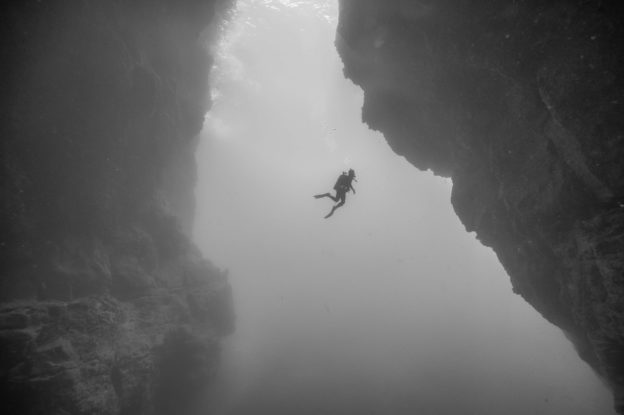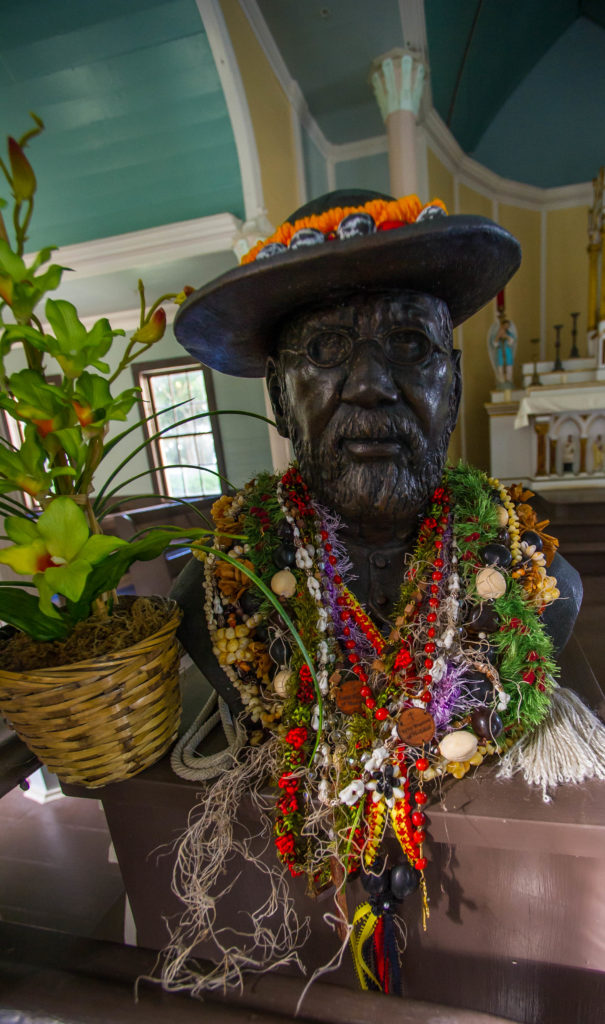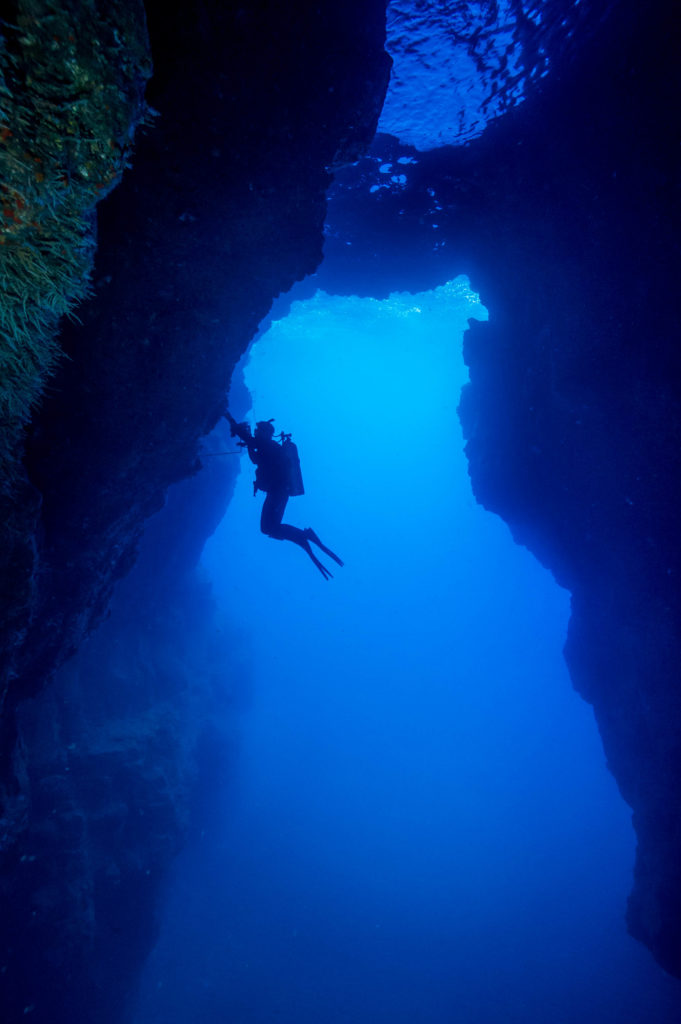It’s two o’clock in the morning at my house in Santa Barbara, CA. All of my housemates are asleep as I milk the last bit of internet I will have for the next week while I’m on the R/V Sea Ranger with Channel Islands National Park (CHIS). I’m trying to book my flight into Kalaupapa National Historic Park (KALA) on the island of Molokai after having no internet at back to back to back stops.
Seems simple enough, there is only one airport listed on the island. I book a flight to O’ahu and then a second over to Molokai and a sense of relief kicks in. I can now peacefully catch 4 hours of sleep and drive to CHIS headquarters.

One of the first sites you see at Kalaupapa is this art piece done by a patient that has since passed.
6 days later and I’m at my mom’s house in Los Angeles checking my email. I see an email from Eric Brown, the Marine Biologist at KALA.
Shaun, you will want to book your flight to KALA (LUP airport code) rather than topside Molokai (MKK) also known as Hoolehua. Otherwise you will have to hike the trail with your dive gear. Not an easy task.
Apparently there is more than one airport on Molokai after all. Several phone calls later, I get on the line with Makani Kai airlines. “You know not just anyone can fly to Kalaupapa. What are you doing there? Who is your sponsor?” the airline representative asks me. I give him the information he needs and 12 hours later, I’m on an 8 passenger plane flying over the highest sea cliffs in the world on the north shore of Molokai.
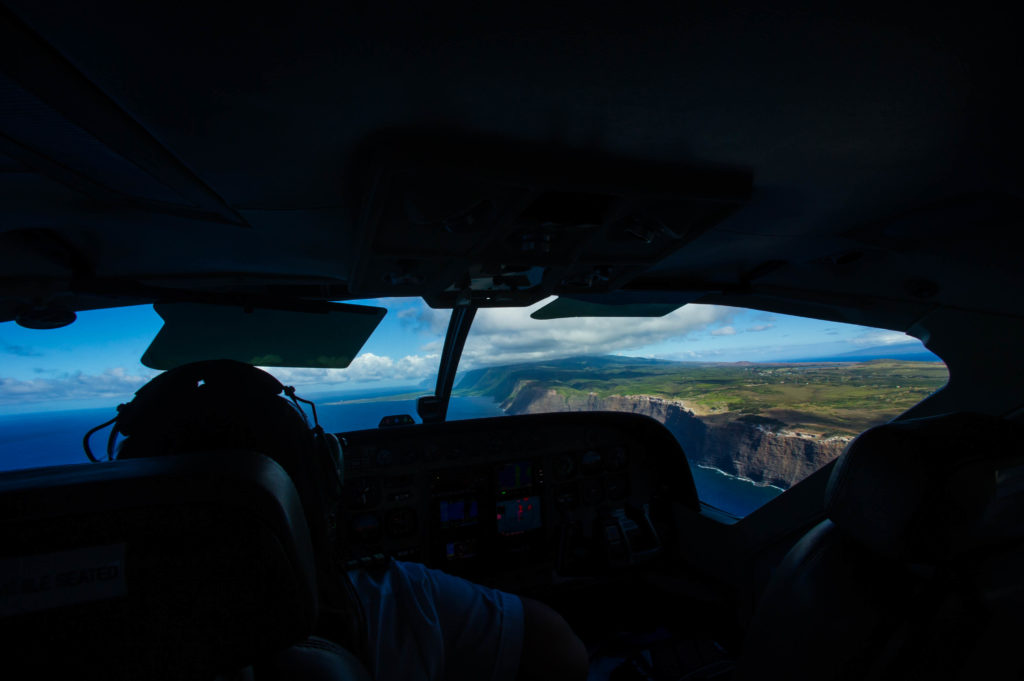
The view from the plane coming into KALA is the stuff dreams are made of.
One of the airline employees based at KALA comes to open the side door, “Ooooh! Looks like we’ve got all the kids on the school bus today!” He proceeds to say hi to almost everyone on the plane. I didn’t have a chance to thoroughly research KALA before I came due to lack of internet. I can tell it is smaller than I thought it was.

Taken from the front row, the planes going into KALA are small-9 people including the pilot!
“You must be Shaun!” Eric picks me out of a very small “crowd” coming off of the plane. I can tell Eric has been in Hawai’i for a long time. His grey hair contrasts with his dark tan and his mismatched flip-flops scream, or rather mumble, that he is an easy going guy.
- The original Catholic church of Kalaupapa.
- Inside the original Catholic Church.
- Father Damien risked his life to care for the patients at KALA when no one else would in the 1800’s. He was later canonized as a saint for his work. He is still highly regarded at KALA though he died long before any of the current patients were born.
We hop in his truck and he shows me around “the settlement,” or Kalaupapa. KALA is located on a small northern peninsula of Molokai. The history behind its current form is that it was founded as a place to send people that had contracted Hansen’s disease. Hansen’s disease is more commonly referred to as leprosy, but as this name brings many negative connotations for the remaining patients at KALA, I will refrain from using it in the blog.
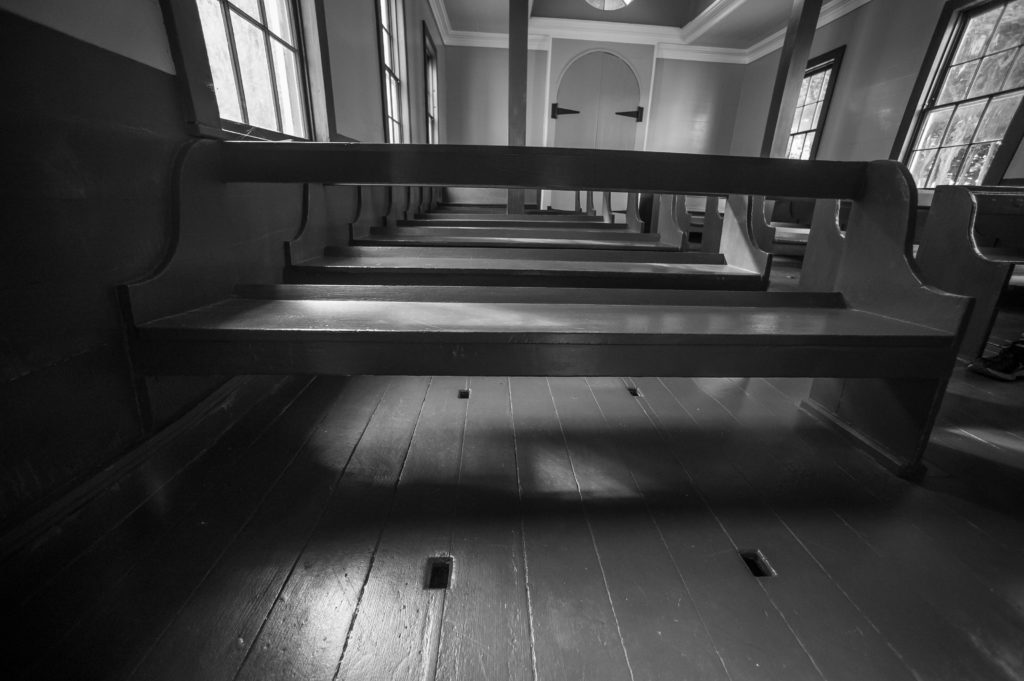
No one really knows why these holes are in the floor inside of the original Catholic church at KALA. Many believe it was for the afflicted to drain fluid from open wounds that they often had.
When Hansen’s disease hit Hawai’i in the 19th century, King Kamehameha V exiled all afflicted to KALA. More often than not these were children, younger than 12 years old. Children are the most susceptible to contracting the disease. They would be ripped from their families and sent to die at KALA since there was no cure. Their families would frequently disown them as well. Hansen’s disease was thought to be genetic and it was taboo to associate with someone who had the disease.
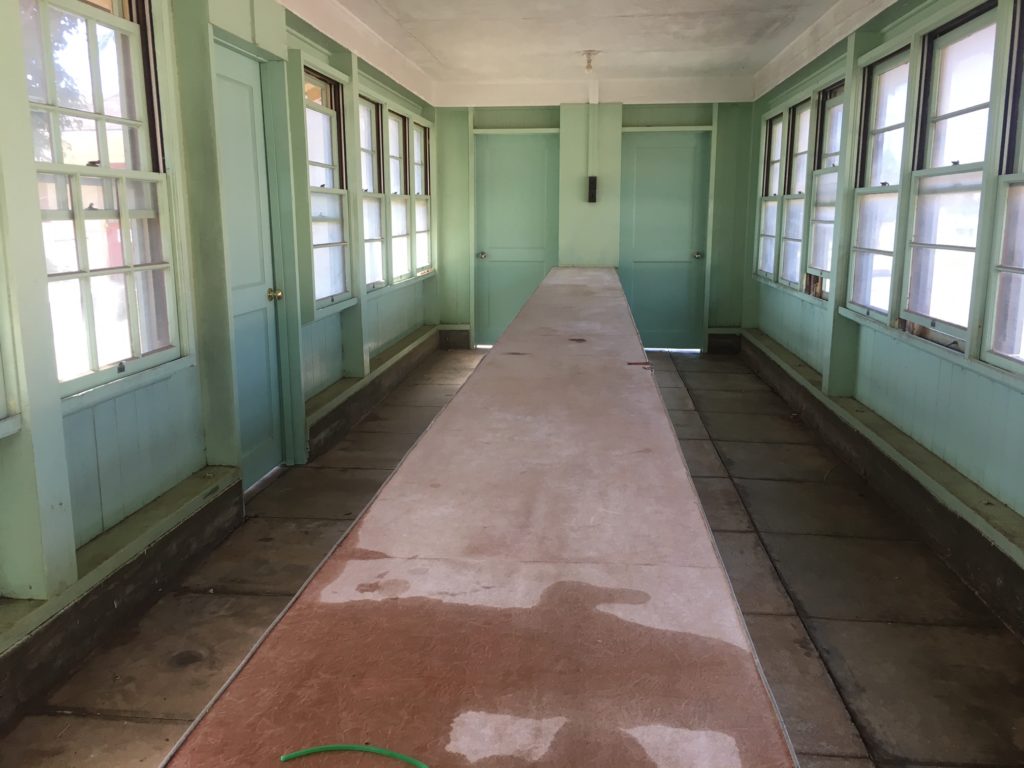
If families wanted to visit their children, it would happen here. Families would be with armed guards on the left and children would be on the right. There was a chain link fence that ran down the middle of this table before Hansen’s disease was cured.
If the families did want to visit, they would do so accompanied by armed guards and speak to their children through a chainlink fence in a small room. Remnants of this intense segregation between patients and everyone else is all over KALA. KALA staff had their own seating sections in any shared space, all staff housing units were fenced in and patients could not enter. During this time, over 8,000 people died at KALA. Many graves are marked, but many more are not. In the 1940’s, a cure was discovered. The remaining patients at KALA were given a choice: stay at KALA and have all of your living and health costs covered forever, or leave and be on your own. Most decided to stay. Not only was the price right, but the community at KALA was the only family they’d known. As a society, we came to find out that Hansen’s disease is one of the least communicable diseases in the world and only 4-5% of the human population is even susceptible.
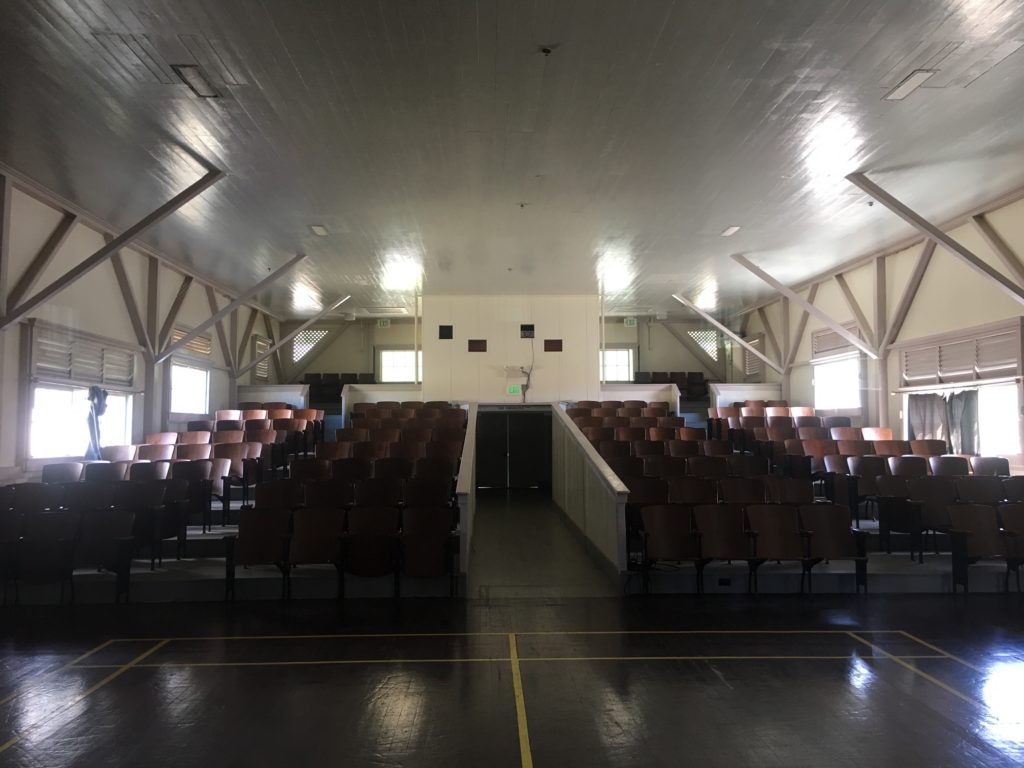
Here in the social hall, the kokua (helpers of patients) sat in the back section, separate from the patients in the from.
Today, KALA is very small. There are about 10 patients and 80 NPS or state employees that live in the settlement. You must be sponsored by a settlement resident to enter. Though small, it is semi-self sufficient by necessity as the settlement isn’t connected to the rest of the island by road. There is a small store (emphasis on small), gas station, hospital/care center, and garden.
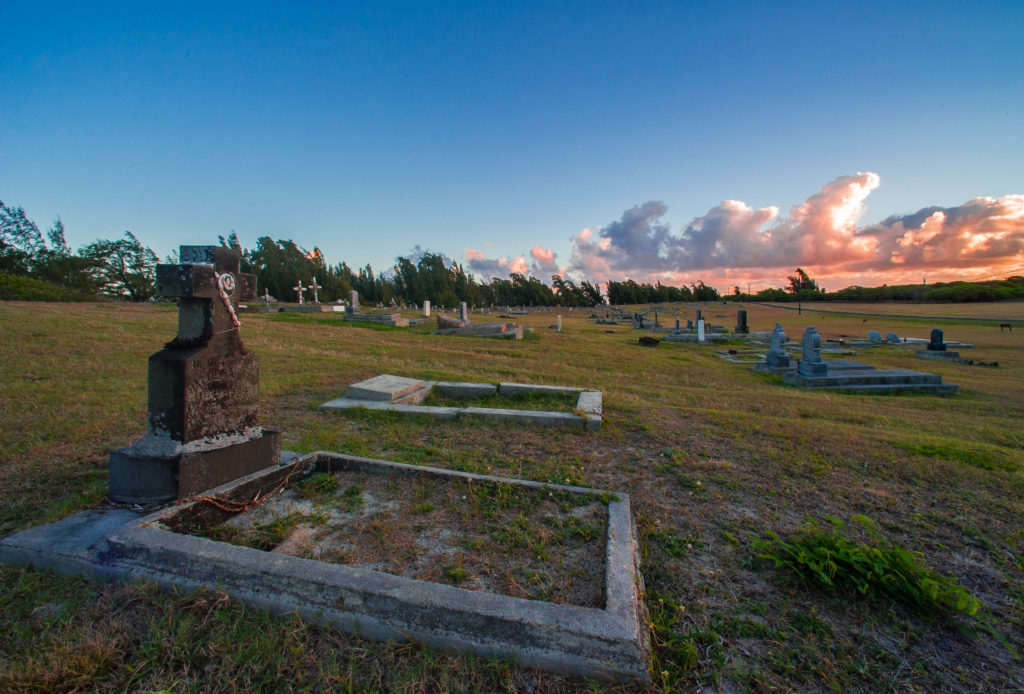
Over 8,000 people have died at Kalaupapa, most of which have been buried in unmarked fields.
As I am getting settled into my new abode, Eric invites me over for dinner, “I’m vegan, special needs child if you will, so there won’t be any meat. Hope you don’t mind!” This is actually music to my ears. My diet is mostly vegan as well and it’s nice to not be a burden on the person cooking for you sometimes.
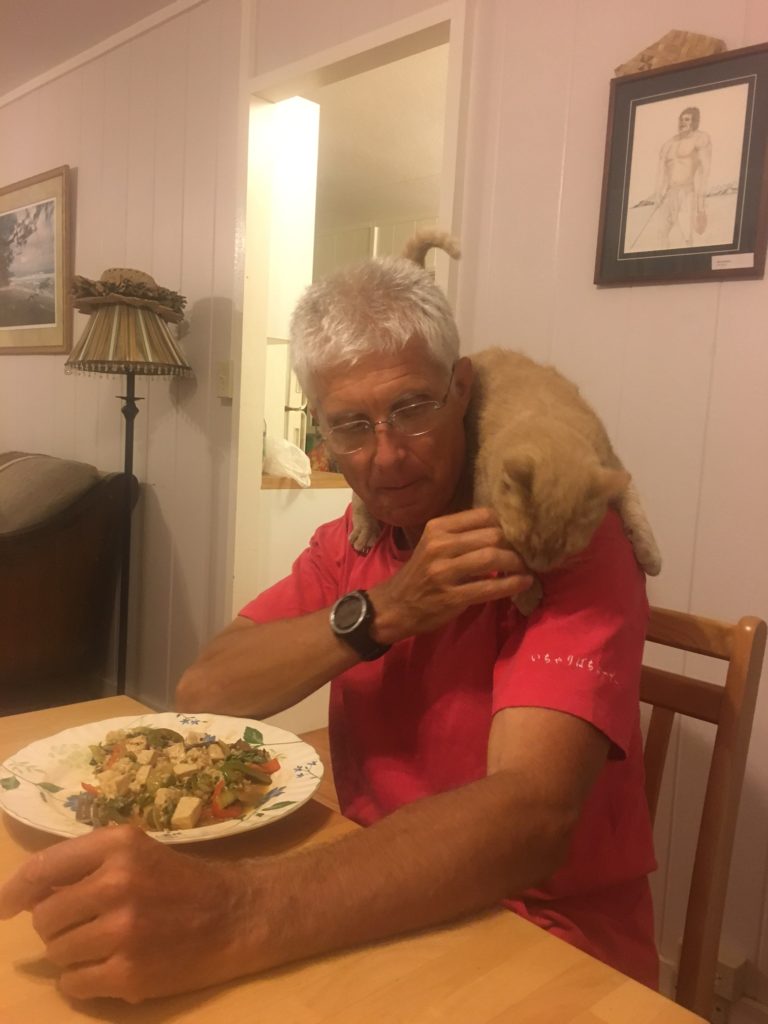
Eric at dinner with his cat that doubles as a neck pillow.
After consuming a massive stir fry, Eric takes me to the backyard. “You like apple bananas? These are ready to go and I can’t eat them all,” he says pointing up to a banana tree. I tell him that bananas would be great, especially since I don’t have food in the settlement yet.
Banana trees only fruit once and grow incredibly quickly. To get the bananas off a tree, you simply cut down the tree. Some equate banana trees to weeds that produce delicious fruit. However, I’ve never actually seen one being cut down. Eric uses what is essentially a butter knife. “You can use anything really, the trunks are real soft, it doesn’t take much!”
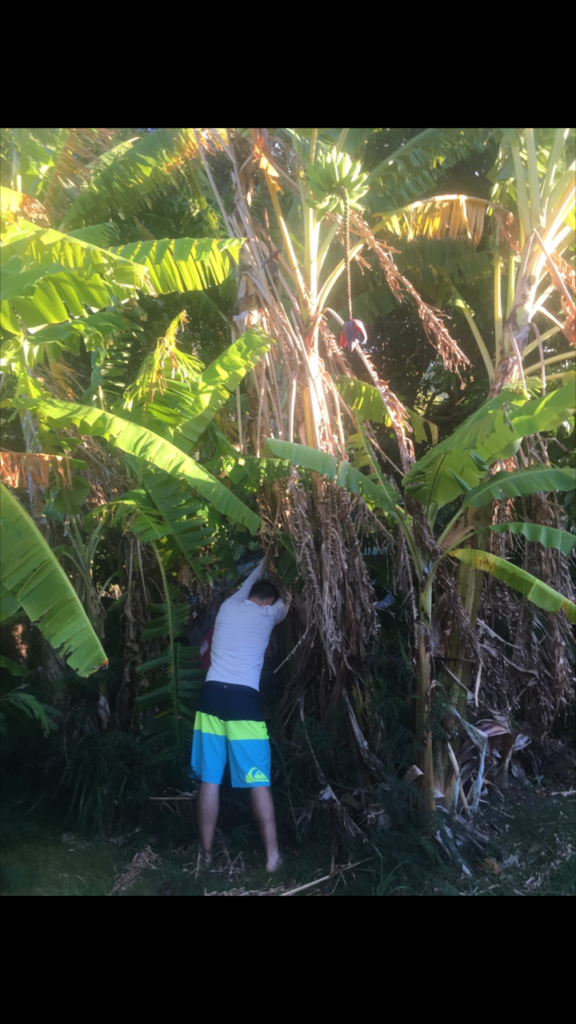
I am still surprised that these big trees come down so easily.
After we mind the banana resin (a stain nightmare for clothing) and grab the bananas, we game plan for the next day. “You need to go get food tomorrow. You’ll have to hike up the trail topside. It takes about an hour each way and you gain a little more than 2000 ft in elevation. Do you have a good backpack?” Eric asks me. “Yeah, I’m all set on a backpack. I just need to know where the trail is,” I tell him. “Ok, that won’t be too hard. Once you’re up there though, you’ll need to get into town. Do you know how to drive stick?” Ahhh, manual transmissions come back to bite me again. This is probably the one skill that I’ve gone the longest without learning when it comes to useful travel skills. “Regrettably, no” I respond. “That’s ok, I believe there is a bus that goes into town now too!”
The hunt for groceries starts at 5:30 AM. After choosing the wrong trail twice, I’m on the right one and half way through my switchbacks up the sea cliffs. “Hey bruddah, howsit?” a local says as he passes me. I haven’t heard “howsit” in a while, I must be back in Hawai’i!
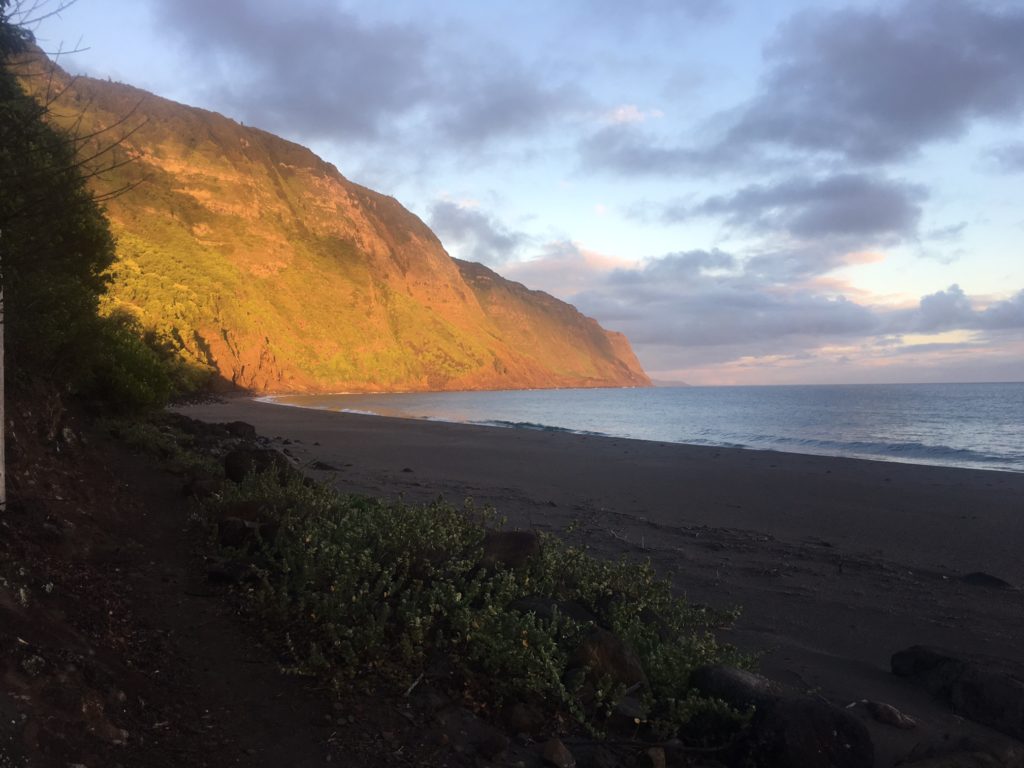
Morning light hits the KALA cliffs.
I get to the top of the trail, hop on the bus, and get into town. Kaunakakai is a funny town. There aren’t many people, but there is always traffic because every car stops in the middle of the road to talk to their friends on the street. It feels like a glimpse into what the rest of Hawai’i was 70 years ago.
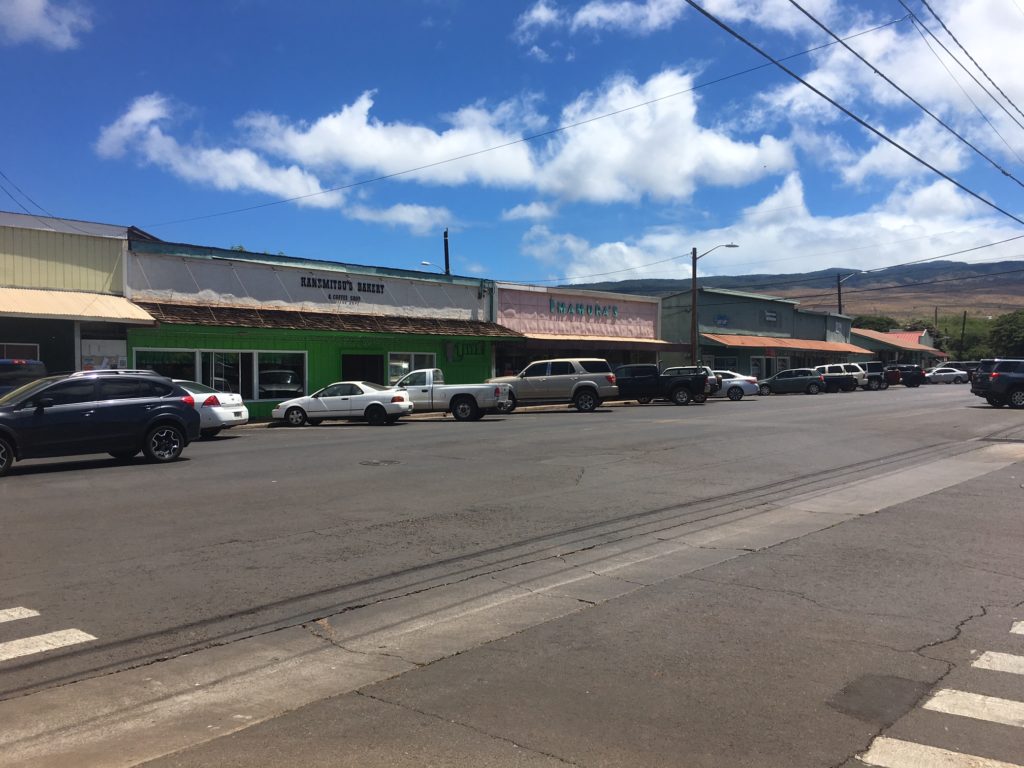
Downtown Kaunakakai feels like my grandfather’s Hawai’i.
After I buy what I need, wait for a few hours, and hop on the bus back to the trailhead, I’m on my way back down. There is an abundance of strawberry guava on the trail and I pick as much of it as I can without slowing down. I’ve never even seen it until now and it is so much better than normal guava.
We have a transect laid out on the ground and I am taking photos with a camera on the side of the transect. “This is exactly it! Keep you’re a constant distance from the ground using your monopod. We will analyze all the photos post-hoc (later) to figure out bottom composition and coral cover,” Eric informs me.
What we are doing is part of a long-term inventory and monitoring project in the park. Eric has a few sites that he goes back to year after year and a few others that are randomly chosen every year. We will be doing benthic surveys using the camera at each of these sites. This portion is my responsibility, while Eric does fish surveys. Once those tasks are complete, we will measure rugosity of our site (how complex the sea floor structure is). Topside, we will be taking water samples and using mechanical equipment to measure specific water quality parameters.
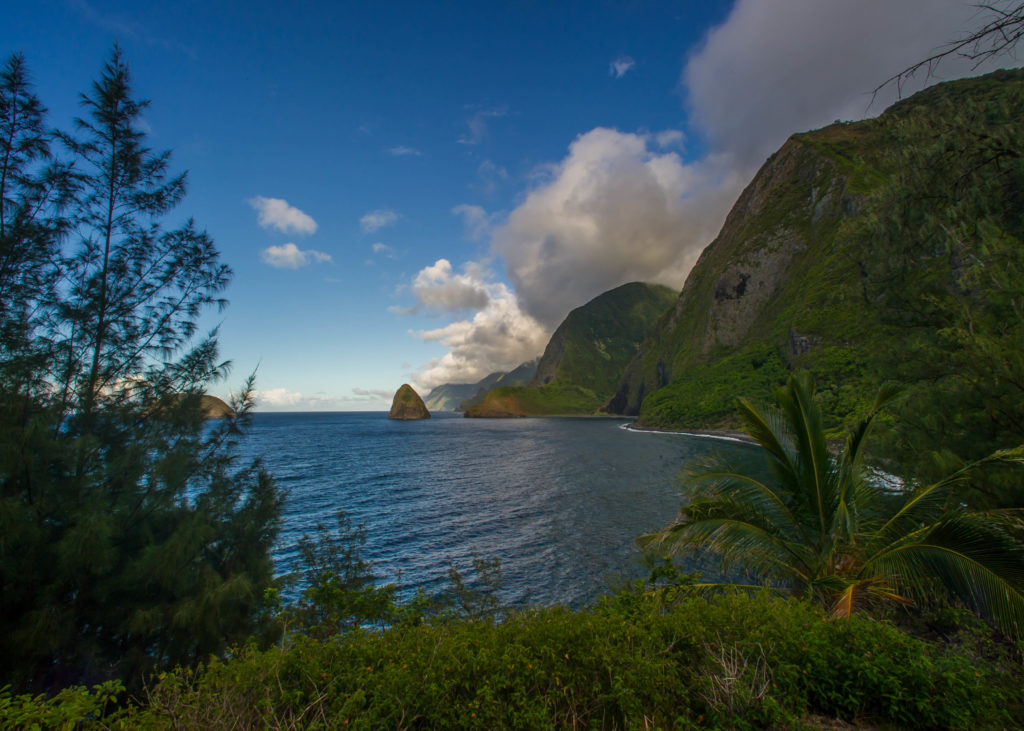
What Kalaupapa lacks in phone service, it makes up for in views.
All of these measurements give a complete picture of how healthy a site is and why it might be that way. More rugose sites (more complex structure) tend to have more fish. Sites with worse water quality will have less coral. These types can only come through long-term projects. One observation could be an anomaly. If the data is the same year after year, we know that it isn’t an anomaly. Furthermore, if the data is changing, we need to look at why and what can be done about it. Why is there better coral growth at this site this year? Is it because of a management practice put in place by the park?

Eric Brown takes a water quality sample with a niskin bottle.
Eric, more than anyone, understands the importance of this. He is a true scientist, whose mantra is “data or die!” He has the motivation of someone half his age. His determination to get the data is exactly what is needed at KALA, where he is on his own and doesn’t really have a “staff” underneath him. He’s a data cowboy of sorts, on a wild frontier where he works with whatever equipment he can get. He is the marine team here and it’s because of him this study has been happening.
“Our truck has good drainage, eh?” a park employee says as he points to the eroded truck bed. The constant exposure to salt at KALA is brutal for the vehicles. Eric washes the truck with freshwater after every dive day, but the space between the bottom of the tuck bed and the side walls is completely gone.
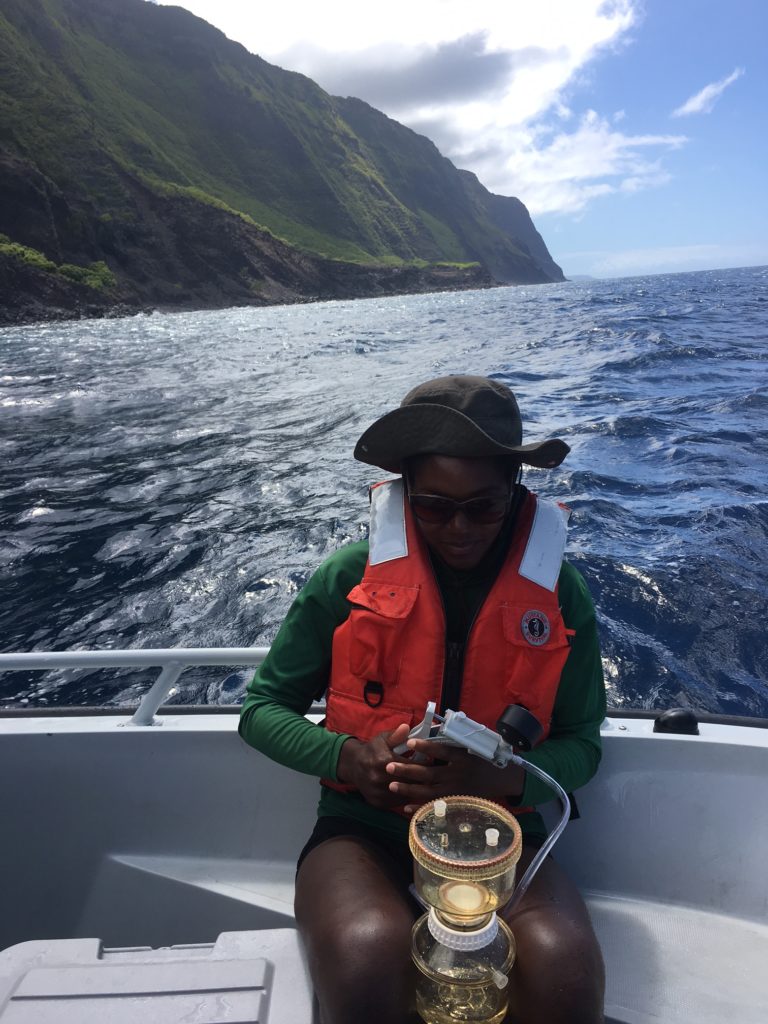
Laurene filtering sea water for a sample.
We load up the truck with all of our gear for the day and head out. Laurene, a park intern from France, is coming out with us today since her focus is mostly on water quality. This is her second tour in Hawai’i after working in O’ahu last summer. She is entering the natural science field after a stint in business management and is pretty giddy about it. Though she gets sea sick, she has an infectious laugh that keeps the crew in good spirits.
“This is going to a beautiful site baby! I can just tell!” Eric exclaims as we pull up to our dive site. We grab our gear and descend on a very boulder-y site with sporadic coral and excellent visibility. Things go smoothly underwater and we work through small kinks here and there. I see a couple umilo (blue fin trevalley), which I immediately anoint as my second favorite fish (the first being the Hawai’ian state marine fish, humuhumunukunukuapua’a).
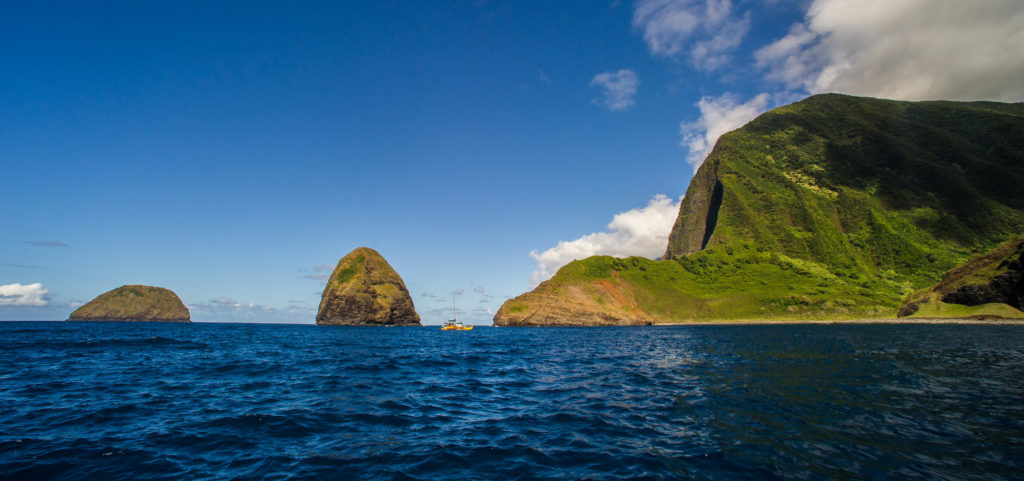
One of the only boats we saw all week. There isn’t much traffic at our survey sites.
Back on the boat, we take several water quality samples to send to USGS, who partners with NPS and analyze the samples in a lab. We also use a sonde to measure local water quality. This machine has three probes that measure temperature, dissolved oxygen, chlorophyll, and many other water quality indicators.
Though visibility is incredible around KALA, the ocean is generally not calm. As we begin to take big swells, it becomes harder and harder to take water quality samples and filter our samples into small bottles. Especially since we are working from the bow- the place on the boat that experiences the most movement.
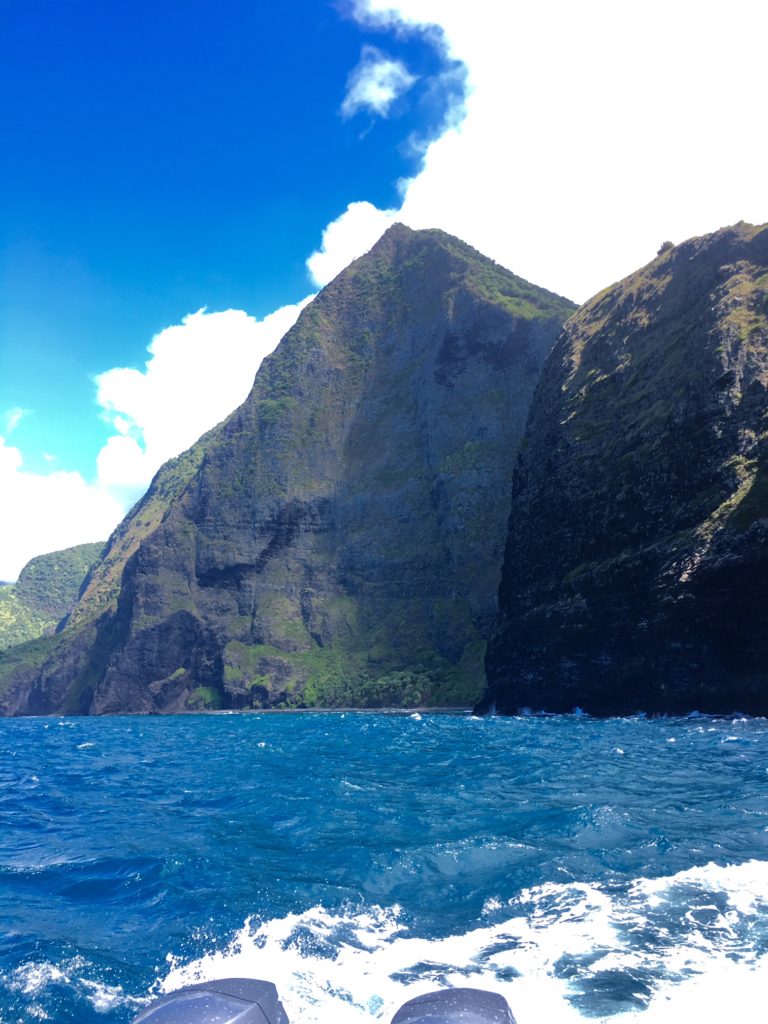
The sea cliffs around KALA are majestic and top 3,000 feet.
Eric then drops an empty sample bottle with a big swell. As we hear the bottle hit the deck, he shouts, “just how I planned it! Constant supervision!” We quickly finish our sampling after that and one more survey dive to call it a day.
After two more days of diving, today we may have time for one fun dive. We have spent the last two days diving on the far side of the peninsula around a few small off shore islands. One of the islands has a crack in it that starts at the surface and goes all the way to the bottom of the ocean at 80 ft. “The crack is huge, it’s like a giant swim-thru arch that you could drive a double decker bus through,” Eric tells me. He lets me bring my camera on board today as well, knowing we might squeeze a dive in at that site.
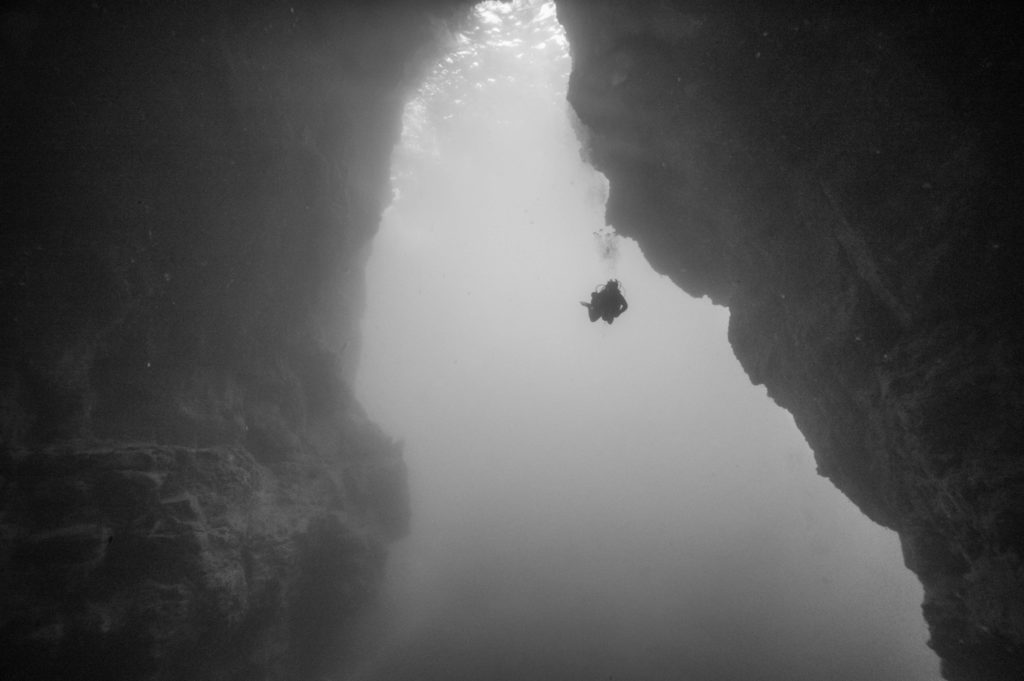
I was hoping to dive the arch all week. I’m so grateful that Eric allowed it!
After two survey dives, we eat lunch and decide that we have enough time to do the arch. When I get in the water, I almost have to put a hand over my regulator to keep it from falling out of my mouth. My jaw drops at the majesty of this arch. It is massive and so unique. I have never seen anything like it. I feel like I’m entering an underwater holy palace in a fantasy world.
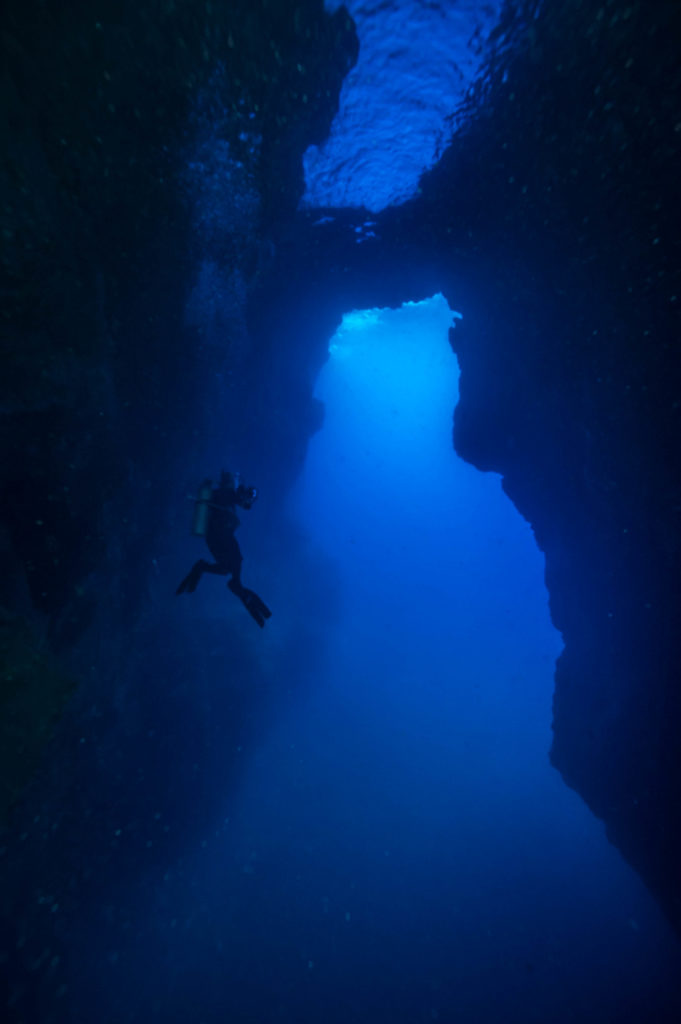
Perhaps the craziest thing about the arch is the air pocket inside. Here you can see the entrance to the arch and above it, the air pocket.
After swimming as fast as possible to get in front of the other diver with me, I take some shots to try to use him as a way to scale the arch. It’s tough since he doesn’t really know this is my plan and I’m quite a distance from him. We then decide to surface in the airpocket at the top of the arch. The air pocket is inside the island and does not connect to the ambient air outside. This is my first experience surfacing inside of a giant rock before. It’s so bizarre. I take my regulator out and try to take a breath. Bad move. Let’s just say the air in there is not the best.
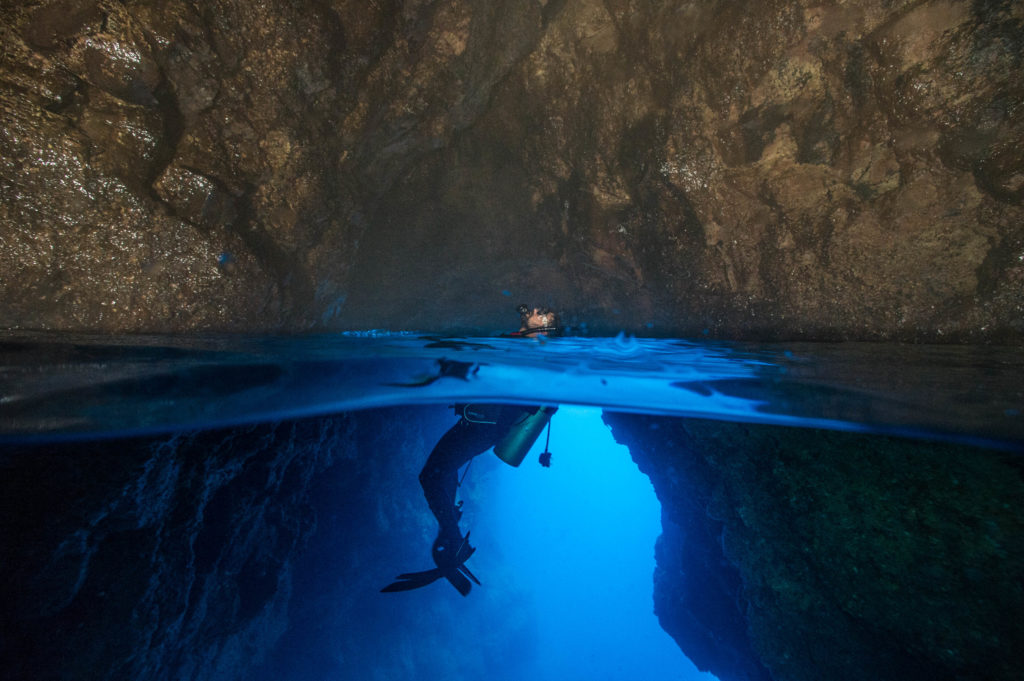
Best to keep your regulator in- the air in here isn’t fun to breathe.
We then swim back down and out the other side of the arch where Eric picks us up. I am elated. I have done a lot of incredible diving this summer, but this dive is on a very short list of dives that have blown my mind.
- Inside the arch with the air pocket above. Besides a little bit of sea grass a sparse populations of fish, not much lives in the arch.
It’s the famous Friday night movie night at KALA tonight. I accompany Eric and his wife to see Gaurdians of the Galaxy 2 at Tim’s place. Tim is the chef for the remaining Hansen’s disease patients. A bunch of people from the community come and bring a plethora of delicious food- mostly vegan to include Eric in the festivities. Tim is the ideal host. He goes above and beyond for his guests and never stresses out about it. I have spent most of my days on the boat, so I haven’t gotten to experience much before now. However, this is a glimpse of the community at KALA. It is a tight-knit group where everyone knows everyone and everyone contributes. I can see why Eric has stayed here so long.
It’s my last night in the settlement before Eric, Laurene, and I go into the backcountry to do stream surveys next week. I can hear a large and blissful crowd inside a large well-lit historical hall. It’s the banquet for the annual KALA fishing tournament.

Not a bad venue to kick off the fishing tournament.
There is a NOAA team at KALA as well that helped put on the fishing tournament. I was lucky enough to see their speech at the start of the tournament, in which they tried to get the fishermen to use barbless hooks. I was really impressed at the stance that the team took and the rhetoric they were using with the locals.
“These hooks, they still catch fish. Hooking a turtle is illegal. We aren’t going to report you guys, that isn’t our goal. Please tell us though, it is important that we know when a turtle is hooked. If you use the barbless hooks, it’s so much easier to unhook a turtle or a seal. I use these hooks, all these guys (points behind to photos of fishermen with 100 lbs + fish) used these hooks. You’ll still catch fish and the marine life will be happier.”
– NOAA Representative from the Barbless Hook team
They offered free barbless hooks and a special prize to the fishermen who caught the biggest fish on a barbless hook. Ultimately they got a couple fishermen to switch over to barbless. While their method isn’t inspiring rapid change, it is inspiring change and they have an extremely good relationship with the locals. In my mind, they are doing outstanding work and maximizing their effectiveness in their situation.
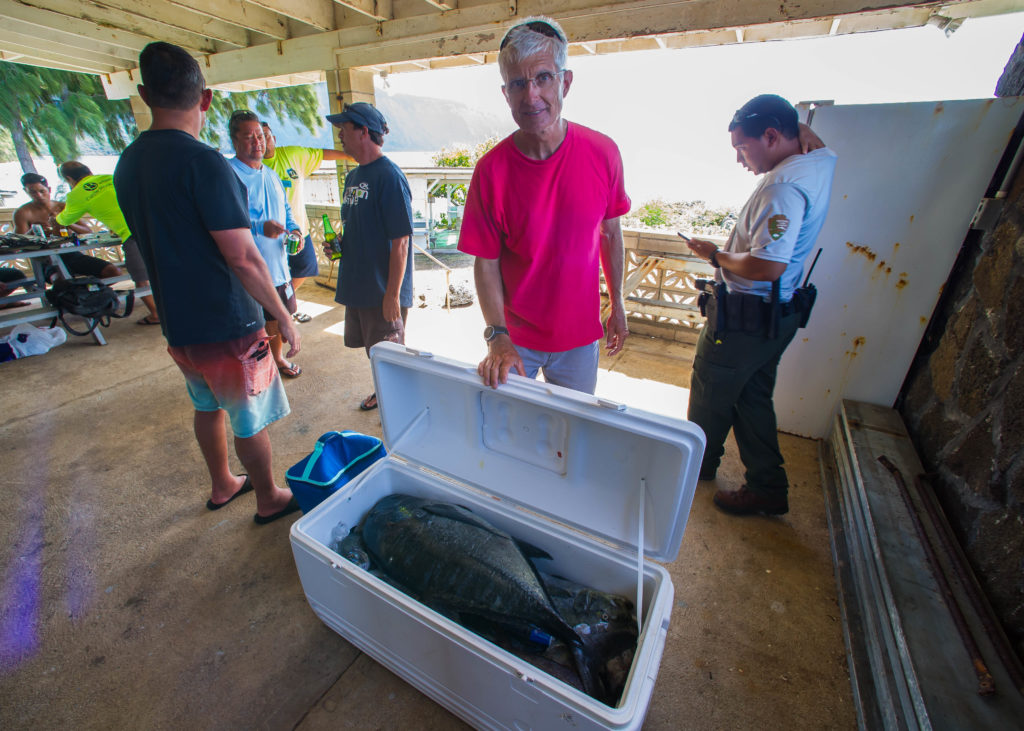
Eric Brown with the biggest catch of the tournament, a 35 lbs ulua.
The banquet concludes with a massive meal of all the fish from the tournament and local Hawai’ian food like poi (mashed taro to the point of liquid). As I chat with some KALA residents and take in the Hawai’ian music played with a ukulele, spoons, and a traditional instrument, I reflect on an incredible week of diving and a big week of backcountry hiking and surveying awaiting me next week.
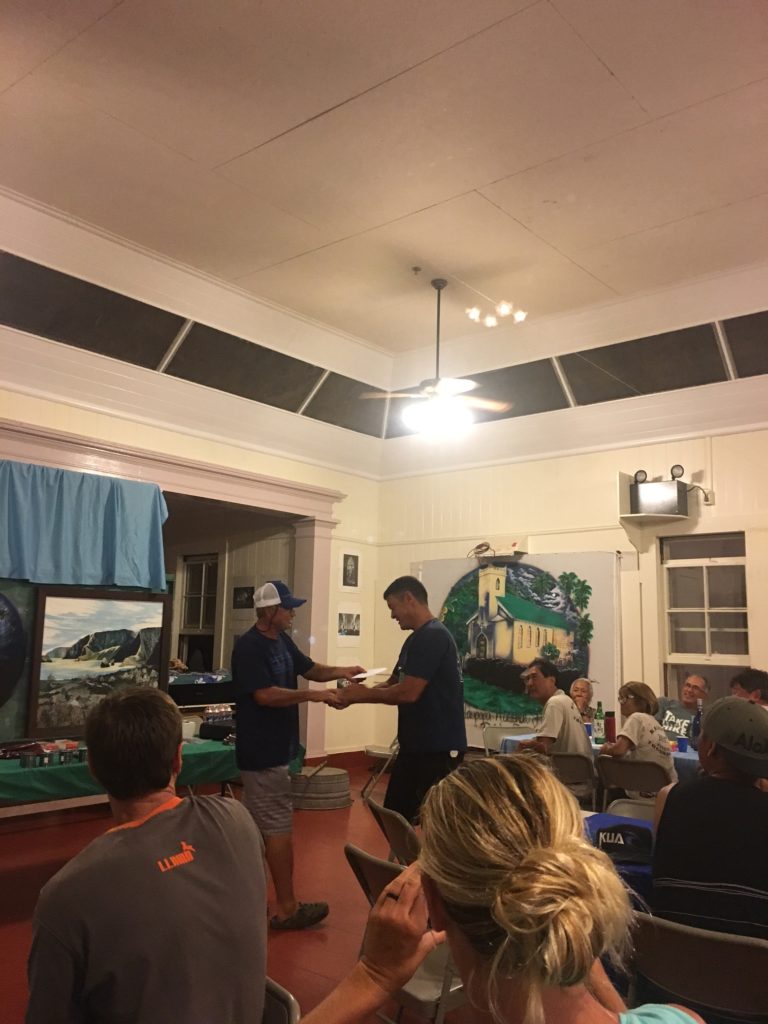
At the banquet, special prizes were given out to fishermen using the barbless hooks.
To be continued…

